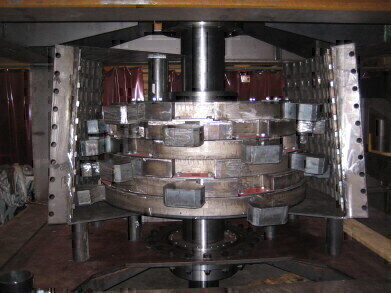Waste Management
New Shredding Technology Shreds Old Wind Turbine Blades
Nov 11 2010
Even though the cross flow shredder DIABOLO® is not the devil’s advocate, it certainly is a bad omen for all disused wind turbine blades that are waiting to be disposed of. In a town near Luneburg, in the north of Germany, the shredding technology by Anlagenbau Umwelt + Technik Chemnitz (Germany) has been in operation for about twelve months now. At present, it grinds down eight tonnes of scrap from mechanical biological treatment plants to a standard grain size of two to four centimeters every hour. This process happens continuously on a six-days-a-week basis and serves to “prepare” the shredding device for what there is to come. Soon, it will fulfill its intended purpose and with this it will face its biggest challenge yet, the communition of fibre-glass reinforced rotor blades.
Since 2005, old and worn-out rotor blades from wind power stations can no longer be landfilled in Germany. Even though incineration is still a viable option to dispose of wind turbine blades, it proves to be rather tricky due to the sheer size of the input material. Today’s rotor blades have a standard length of 46 metres and can weigh between nine and ten tonnes. Mirko Winter, general manager of AU+T adds: “The material would definitely have to be cut down before it can be incinerated. However, due to the lack of suitable tools, the high degree of material wear as well as health and safety issues that may arise with regard to the amount dust that is released during the cutting process, the incineration of rotor blades is still not practical.” Thanks to the DIABOLO®, one needs no longer waste thoughts on incinerating rotor blades because the shredding device is going to be at the core of a new process that can recycle this oversized input material without difficulties and without leaving any residues.
During the treatment, the rotor blades are pre-shredded and then they are fed into the DIABOLO®, which disintegrates material compounds and crushes the input material to homogeneous grits using its two-stage process. Right after the treatment in the 43-tonnes cross flow shredder, metals are separated from non-metal by means of magnetic separators, whereas the fine dust from the rotor blades is extracted by suction. ‘Waste not’ seems to the motto of this process. Everything that is obtained at the end of the process is re-used. For instance, the plastic powder will find a use in the production of concrete. “The first couple of tests with the rotor blades were a major success. You see, a devil just cannot be intimidated that easily,” Mirko Winter laughs.
The cross flow shredder DIABOLO® unites two processing steps in one machine, which can get different types of input material such as WEEE, scrap from mechanical biological treatment plants, refrigerators or rotor blades, down to a pre-defined homogenous size. Further treatment steps including granulation, manual sorting and hammer milling are not required when using this machine. At first, the material is pre-crushed by means of a rotating chain in the upper chamber of the machine. The breakdown of material occurs, for the most part, due to the force of the impact between the input materials as they are smashed together. The conically shaped processing chamber enables an optimal and unproblematic material feeding. Subsequently, the pre-processed material is dropped into the second comminuting chamber through an adjustable chute. As the chute is regulated by means of hydraulic cylinders, the maximum size of the material that reaches the second chamber can be determined.
Finally, in the second comminuting chamber the material is grinded down to a homogeneous grit size, which happens by means of a technology that can be compared to a hammer mill. The shell that encases the hammer mill is adjustable in height by means of several hydraulic cylinders and expands conically from top to bottom. Using flexible beating elements which are attached to conically arranged hammer disks inside the shell, the material is milled vertically top down to a uniform grit size that has a minimum diameter of 10 millimetres.
By the end of 2009, there were 21,164 wind turbines in operation in Germany. It seems like the DIABOLO® will not be running out of work so soon.
Events
Apr 22 2024 Hannover, Germany
Apr 23 2024 Kuala Lumpur, Malaysia
Apr 24 2024 Sao Paulo, Brasil
May 05 2024 Seville, Spain
May 13 2024 Munich, Germany














